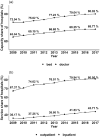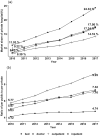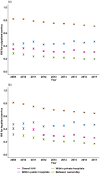The Evolving Hospital Market in China After the 2009 Healthcare Reform
- PMID: 33124476
- PMCID: PMC7607735
- DOI: 10.1177/0046958020968783
The Evolving Hospital Market in China After the 2009 Healthcare Reform
Abstract
Since the initiation of national healthcare reform in 2009, China's hospital market has witnessed significant change. To provide a brief description about its evolving process, China Health Statistical Yearbook data and Sichuan administrative data from 2009 to 2017 were used in this article. An overall upward trend of hospital delivery capacity was found in this study, which increased from 3.12 million beds and 1.09 million doctors in 2009 to 6.12 million and 1.80 million in 2017, respectively, while the primary healthcare institutions presented fairly slow development pace. Growing proportion of medical resources and patients gathered in hospitals, especially tertiary hospitals. While private hospitals demonstrated an increasingly important role in hospital market with growing share of capacity and service, their average capacity, especially the human resource, was found to be much lower than that of public hospitals and the gaps are still widening. The competition among hospitals grouped by homogeneous ownership types has predominated the increasingly intensified hospital market competition in China. In order to adapt to the raising demand of health care in China, it is highly recommended that strategies forged at governmental levels be focused on primary care promotion, guiding the development of private hospitals as well as on promoting orderly competition in the hospital market.
Keywords: China; capacity; hospital competition; market share; medical service.
Conflict of interest statement
Figures






Similar articles
-
Private hospital expansion in China: a global perspective.Glob Health J. 2018 Jun;2(2):33-46. doi: 10.1016/S2414-6447(19)30138-1. Epub 2019 Sep 25. Glob Health J. 2018. PMID: 32501412 Free PMC article. Review.
-
The Association of Market Mix of Hospital Ownership With Medical Disputes: Evidence From China.Inquiry. 2020 Jan-Dec;57:46958020971403. doi: 10.1177/0046958020971403. Inquiry. 2020. PMID: 33233980 Free PMC article.
-
Expanding public health in China: an empirical analysis of healthcare inputs and outputs.Public Health. 2017 Jan;142:73-84. doi: 10.1016/j.puhe.2016.10.007. Epub 2016 Nov 22. Public Health. 2017. PMID: 28057203
-
Comparison of the market share of public and private hospitals under different Medical Alliances: an interrupted time-series analysis in rural China.BMC Health Serv Res. 2024 Apr 22;24(1):496. doi: 10.1186/s12913-024-10941-0. BMC Health Serv Res. 2024. PMID: 38649910 Free PMC article.
-
China's Health Reform Update.Annu Rev Public Health. 2017 Mar 20;38:431-448. doi: 10.1146/annurev-publhealth-031816-044247. Epub 2017 Jan 11. Annu Rev Public Health. 2017. PMID: 28125384 Review.
Cited by
-
Differences in inpatient performance of public general hospitals following implementation of a points-counting payment based on diagnosis-related group: a robust multiple interrupted time series study in Wenzhou, China.BMJ Open. 2024 Mar 12;14(3):e073913. doi: 10.1136/bmjopen-2023-073913. BMJ Open. 2024. PMID: 38471900 Free PMC article.
-
Levels, trends, and determinants of effectiveness on the hierarchical medical system in China: Data envelopment analysis and bootstrapping truncated regression analysis.Front Public Health. 2022 Sep 20;10:921303. doi: 10.3389/fpubh.2022.921303. eCollection 2022. Front Public Health. 2022. PMID: 36203685 Free PMC article.
-
The difference in patient-centered medical experiences between public fertility care and private fertility care in China: a multicenter cross-sectional study.BMC Public Health. 2025 May 21;25(1):1874. doi: 10.1186/s12889-025-22893-z. BMC Public Health. 2025. PMID: 40399859 Free PMC article.
-
Is there any difference in organizational commitment between general hospitals and specialized hospitals? Empirical evidence from public hospitals in Beijing, China.BMC Health Serv Res. 2023 Dec 12;23(1):1397. doi: 10.1186/s12913-023-10362-5. BMC Health Serv Res. 2023. PMID: 38087250 Free PMC article.
-
Rapid growth of private hospitals in China: emerging challenges and opportunities to health sector management.Lancet Reg Health West Pac. 2023 Dec 19;44:100991. doi: 10.1016/j.lanwpc.2023.100991. eCollection 2024 Mar. Lancet Reg Health West Pac. 2023. PMID: 38156262 Free PMC article. Review.
References
-
- State Council. The performance direction of the health care reform of the programs from 2009 to 2011 (in Chinese). State Council. http://www.gov.cn/test/2009-04/08/content_1280057.htm. Accessed October 13, 2019.
-
- State Council. The state council issued a notice on the work arrangements for the five major reforms of the medical and health care system in 2009. State Council. http://www.gov.cn/zhengce/content/2009-07/23/content_6221.htm. Accessed August 31, 2019.
-
- State Council. Opinions of the state council on establishing and improving the compensation mechanism for primary health care institutions. State Council. http://www.gov.cn/zhengce/content/2010-12/14/content_6178.htm. Accessed December 1, 2019.
-
- Liu X, Wang Q, Sara B, Yang W, Dong S, Li H. The technical efficiency of community health service centers in Wuhan, China: estimation and policy implications. Inquiry: J Health Care Org Provis Financ. 2018;55:0046958018812972.
-
- Yip W, Fu H, Chen AT, et al. 10 years of health-care reform in China: progress and gaps in Universal Health Coverage. Lancet. 2019;394(10204):1192-1204. - PubMed
Publication types
MeSH terms
LinkOut - more resources
Full Text Sources

